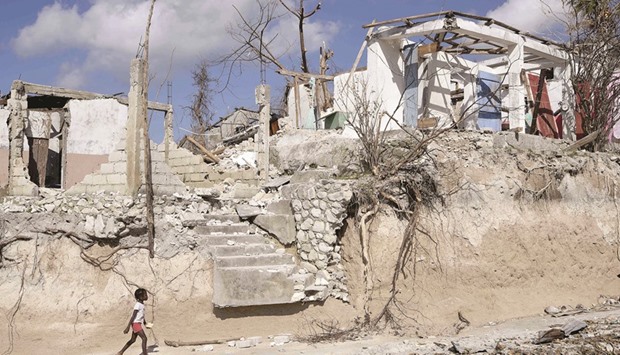In the many years that I’ve been writing for the Gulf Times, I’ve never written about the same weather event twice in a row. However, this week I will break that rule. Since I wrote last week’s Weather Addict on the unusual behaviour of Hurricane Matthew, the full horror of the storm’s impact has been laid bare. Over one thousand people were killed by the storm in Haiti and its impact will be felt by the hurricane’s survivors for many years to come.
In our Weather Office at Al Jazeera, on the other side of the planet to the storm, we followed Hurricane Matthew’s every move. We poured over the forecasts and dissected all the information we had to hand. We examined the sea temperatures, the geography of the land, anything that would give us an insight into the expected behaviour of the powerful system. We knew every time the winds of Hurricane Matthew changed in intensity, we knew every small change in the storm’s track and we knew exactly where the storm was forecast to hit next.
In Haiti, however, it was a very different story. Even though the storm was headed towards the country, the locals didn’t have this up-to-date information. In fact, in many cases, the locals didn’t have any information at all. The country is extremely impoverished. People in the region don’t have television or even radio. The only reason that they knew that the storm was coming was that humanitarian agencies deployed people to visit the various towns and villages and physically knock on the doors of people’s homes to tell people that the storm was coming.
As you can imagine, this method of broadcasting information would have been rather time intensive. It’s also worth mentioning that the hurricane wasn’t always forecast to make landfall in Haiti. Just three days before the storm hit Haiti, it was expected to hit Jamaica instead. Each time the forecast was issued, the projected track of the storm edged a little further east. It was only about 48 hours before it made landfall that Hurricane Matthew was forecast to actually hit Haiti. How much time would it have taken to knock on all the doors of the houses is anyone’s guess. Did everyone receive the warning? Were the warnings accurate? The answer to one or both of the questions is almost certainly no, because if it had been explained just how severe and life threatening the hurricane was going to be, people surely would have moved out of the way.
After Hurricane Matthew hit Haiti, it slammed into Cuba. The southeast of the country suffered similar damage to southwestern Haiti, but the difference in death toll was stark. Not one person is reported to have died in Cuba. The reason is simply because the people of Castro’s country moved out of the way. If a hurricane or tropical storm approaches the island, the government issues a mandatory evacuation order, and people move. Year after year, this policy has saved lives and this is why Cuba retains such an impressively low death toll from even the strongest of hurricanes.
In Haiti, the people weren’t ordered to leave. Some may argue that in such a poor country, there would be little options of where to go, but frankly anywhere would have been better than in the eye of a category four hurricane. Despite the approaching danger, people stayed in their homes. Some of them may have known that a storm was coming, but they probably weren’t aware of the full strength of the hurricane. They simply hoped and prayed that their homes would offer them some protection against the elements. Unfortunately, in many cases they didn’t.
The vast majority of homes in Haiti are rustic to say the least. After slamming the Caribbean islands, Hurricane Matthew hit Florida, but the damage was minimal. In Florida, the houses are well-built, made of solid breeze blocks and are designed to withstand extreme winds. In Haiti, the homes are made of any materials that are found lying around. Generally, they are made of wood, with corrugated iron roofs. As winds of 235 kph (145 mph) hit the island, these basic homes were simply ripped apart, and the winds turned the individual pieces of building material into deadly missiles. The locals were left in the path of the storm with no protection whatsoever.
The impact of Hurricane Matthew would be devastating for any country to deal with. Both Cuba and South Carolina will be clearing up after the storm for many months to come. In Haiti, however, the impact of the hurricane can’t be looked at in isolation. The country has lurched from one natural disaster to the next. One of the most horrific being the earthquake of 2010, which killed more than 200,000 people. Haiti has yet to recover from this disaster, with tens of thousands of people still living in camps, some of which have been hit by disease. Almost 10,000 people have been killed by cholera since the earthquake, which tragically was triggered by the UN, the very organisation that many Haitians were counting on to save them.
For the last three years, the country has also been struggling in a drought. For a country of subsistence farmers who live hand to mouth, this has hit the locals particularly severely. In April, the World Food Organisation estimated that five million people in Haiti suffered food insecurity. Just as Haiti had begun to emerge from this drought, the country was cruelly struck by a monstrous hurricane. The people of the country must feel like life can’t get any worse. And then it does.

DESTRUCTION: A girl walks in Port Salut, Haiti, on October 12, following the passage of Hurricane Matthew. A week after Matthew tore through the country, many remote areas’ communities were still left to their own devices. Families with destroyed homes and shattered livelihoods waited and prayed for help.


